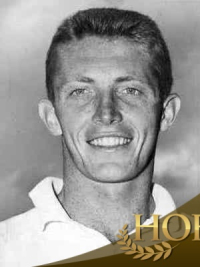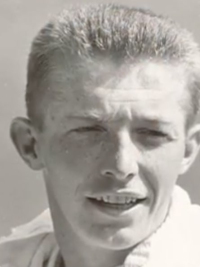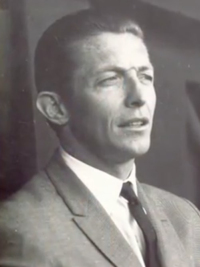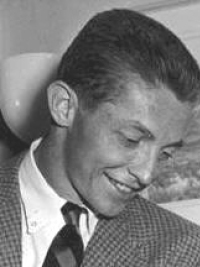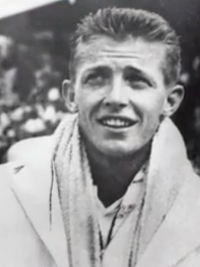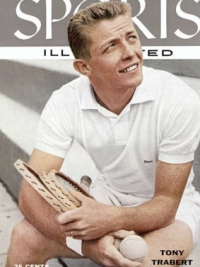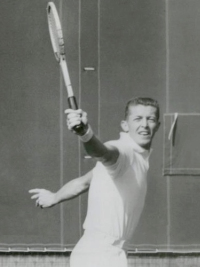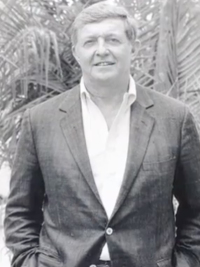Tony Trabert
Full name: Marion Anthony Trabert
Nickname: Tony, Bubbie
Nickname: Tony, Bubbie
| Born |
Subscribe now
This information and data is not available because you are not our subscriber yet.
Please click here and get full access to the entire database! |
|---|---|
| Died | |
| Class of HOF | |
| Height | |
| Weight | |
| Plays | |
| Bio | One of the finest seasons ever achieved was the 1955 of Tony Trabert, who won three of the Big Four singles titles - Wimbledon, French, and U.S. - to earn acclaim as the No. 1 amateur of that year. Only three other men, Don Budge (1938), Rod Laver (1962 and 1969) and Rafael Nadal have won those three upper-most championships within a calendar year (Budge and Laver en route to their Grand Slams). Moreover, Trabert also won the U.S. Indoor and U.S. Clay Court titles, adding them to the pre-eminent American championships on grass at Forest Hills. For that year, probably the most productive ever by an American man - 30 titles - he won 18 of 23 singles tourneys on a 106-7 match record. Included was a winning streak of 36 matches. He also won 12 doubles titles (with Vic Seixas). An exceptional athlete, Marion Anthony Trabert was born Aug. 16, 1930, in Cincinnati, where he grew up. He was a standout basketball player at the University of Cincinnati, for which he also won the U.S. Intercollegiate singles title in 1951. The French Championships has traditionally been the most difficult battleground for American men. Trabert won five titles in Paris, the singles in 1954 and 1955. It was 34 years before another American, Michael Chang, won in 1989. Trabert also won the doubles in 1950 (with Bill Talbert) and in 1954 and 1955 (with Vic Seixas). Only a defeat by Ken Rosewall (the eventual champ) in the semi-finals of the Australian Championships ruined Trabert's chance at a Grand Slam in 1955. For five years Trabert was a mainstay of the U.S. Davis Cup team, along with Seixas. In each of those years the U.S. reached the challenge round finale, and Trabert's best-remembered match may have been a defeat, a tremendous struggle against Lew Hoad on a rainy afternoon in 1953 at Melbourne. Hoad won out, 7-5, in the fifth, and Australia kept the Cup. However, Trabert and Seixas returned to Australia a year later, where Trabert beat Hoad on the opening day in singles and he and Seixas won the doubles over Hoad and Rex Hartwig in a 3-2 triumph, the only U.S. seizure of the Cup from the Aussies during an eight-year stretch. Though an attacker with a powerful backhand and strong volley, the competitive right-hander also had exceptional groundstrokes. In winning the U.S. singles at Forest Hills twice, 1953 and 1955, and Wimbledon, 1955, he did not lose a set, a rare feat. Amassing 13 U.S. titles in singles and doubles, he was one of two Americans (the other was Art Larsen) to win singles championships on all four surfaces: Grass at Forest Hills, indoor, clay court and hard court. Following the custom of the time, Trabert, as the top amateur, signed on with the professionals to challenge the ruler, Pancho Gonzalez, on a head-to-head tour in 1956. Gonzalez won, 74-27. Trabert was runner-up to Alex Olmedo for the U.S. Pro singles title in 1960, having won the doubles with Hartwig in 1956. When his playing career ended, Trabert worked as a teaching pro and as a television commentator on tennis. In 1976 he returned to the Davis Cup scene as the U.S. captain, leading the Cup-winning teams of 1978 and 1979. He had four years in the U.S. and World Top Ten, 1951, 1953, 1954 and 1955, No. 1 in each in 1953 and 1955, before turning pro. His amateur career was interrupted by service in the U.S. Navy. He was named to the Hall of Fame in 1970. Source:Bud Collins (re-edited by DB4Tennis) Trabert was a stand-out athlete in tennis and basketball at the University of Cincinnati, and was a member of Sigma Chi Fraternity. In 1951, he won the NCAA Championship Singles title. He played doubles with Bob Mault and was coached by George Menefee, who later became the head trainer for the Los Angeles Rams. Trabert was also a starter on the Cincinnati Bearcats basketball team at the University of Cincinnati. Previously, at Walnut Hills High School in Cincinnati, he had been Ohio scholastic champion three times and played guard on the 1948 basketball team that won the District Championship. A native of Cincinnati, Trabert grew up two houses down from a public park. It had clay courts that helped hone his groundstrokes. By age 11, Trabert was winning junior tournaments and eventually became the world's No. 1 amateur at age 25. He turned pro after winning the ’55 U.S. Championships because he had a wife and two children to support. Trabert honed his tennis skills on the courts of the Cincinnati Tennis Club with the help of another member of that club, fellow International Tennis Hall of Famer Billy Talbert. Talbert became Trabert's mentor. In 1951, Trabert posted his first win over Talbert in the final of Cincinnati's international tennis tournament (now known as the Cincinnati Masters). In 1953, Trabert won the men's singles in the Ojai Tennis Tournament. Trabert's record in 1955 was one of the greatest ever by an American tennis player. He won the three most prestigious tournaments in amateur tennis—the French, Wimbledon, and American Championships—en route to being ranked world no. 1 among the amateurs for that year. In the midst of his amateur career, Trabert's game was interrupted by a two-year stint in the Navy, serving on an aircraft carrier during the Korean War, but this did not stop him. He is one of only seven male players to have won three Grand Slam singles title in a year. Trabert's own chance at a Grand Slam was stopped with a loss to Ken Rosewall in the semifinals at the Australian Championships. Trabert won 18 tournaments in 1955, compiling a match record of 106 wins to 7 losses, which included a 38-match winning streak. An athletic right-hander who mostly played a serve and volley game, Trabert won all five of the Grand Slam singles finals he appeared in. He won the French Championships in 1954 and 1955 (1954 over Mervyn Rose, Budge Patty in the semifinal and Arthur Larsen in the final, and 1955 over Rose in the semifinal and Sven Davidson in the final), becoming the last American man to win that event until Michael Chang in 1989, the U.S. Championships in 1953 and 1955 (1953 over Vic Seixas in the final, and 1955 over Rosewall in the final), and the Wimbledon title in 1955 (over Kurt Nielsen in the final) without losing a set (a record shared with Don Budge, Chuck McKinley, Björn Borg and Roger Federer). Trabert, along with Vic Seixas, was an American Davis Cup team mainstay during the early 1950s, during which time the Americans reached the finals five times, winning the cup in 1954. It was one of only two victories over the dominant Australian teams during the decade (the other being in 1958). He called the 1954 Davis Cup win the "biggest thrill in my tennis career". Having reached the top amateur ranking in 1955, Trabert turned professional in the fall of that year. Trabert explained: “When I won Wimbledon as an amateur, I got a 10-pound certificate, which was worth $27 redeemable at Lilly White’s Sporting Goods store in London. Jack Kramer offered me a guarantee of $75,000 against a percentage of the gate to play on his tour." With a wife and two children to support, the decision was clear. In 1956, he was beaten on the head-to-head world pro tour by the reigning king of professional tennis Pancho Gonzales, 74–27, consisting mostly of indoor matches on a portable loose canvas surface. However, he beat Gonzales in 5 sets at Roland Garros in the final of the 1956 French Pro title. Trabert also won a South American tour against Gonzales in 1956, winning 6 matches against Gonzales outdoors on clay, and losing three matches to the champion indoor, for a 6–3 tour victory. For the year 1956 as a whole, Trabert had an edge over Gonzales in outdoor matches of 15-11 (1-1 on grass, 5–5 on cement, and 9–5 on clay). In the 1958 pro tour, Trabert won a personal series against Segura 34–31, showing that he had adjusted to the portable canvas surface used by the Kramer pros in small indoor venues and gyms. In the Wembley Pro in 1958, he defeated Rosewall in the semi-final and was runner-up to Sedgman . In the French Pro at Roland Garros in 1959, Trabert beat Rosewall in the semifinal and then defeated Frank Sedgman in the final, to win his fourth title at the red clay venue. In the 1960 US Pro (billed as Cleveland World Pro), he was runner-up to Alex Olmedo. In November 1961, Trabert led the United States team into the Kramer Cup final (the pro equivalent of the Davis Cup) at Ellis Park in Johannesburg. Trabert defeated Rosewall in four sets, but lost the fifth and deciding rubber to Hoad in four sets. In October 1962, Trabert won the South African Pro Championships on the cement courts of Ellis Park in Johannesburg by defeating Hoad in the final in five sets. Trabert also had wins over Hoad at the Forest Hills Tournament of Champions in 1957 and 1958. After retiring from the game, Trabert enjoyed a 33-year career (1971–2004) as a tennis and golf analyst for CBS covering such events as the US Open. During many of those years he teamed up with Pat Summerall and was the lead expert commentator at the US Open. The popularity of their broadcasts helped propel the US Open into an annual financial success for CBS and the United States Tennis Association. He was also the US Davis Cup team captain from 1976 to 1980. Trabert's captaincy is remembered by his frustration in dealing with the egos of younger players like John McEnroe, and for his racket-wielding expulsion of anti-apartheid protesters who ran onto the court during a Davis Cup match against South Africa at the Newport Beach Tennis Club in California in April 1977. He was also a tennis author and was a motivational speaker. In 1988, he published a book, Trabert on Tennis, sharing his insights on the game from a player's, coach's, and commentator's standpoint. In 1970, with the encouragement of Dr. Toby Freedman his good friend and doctor, Trabert opened a tennis camp "Trabert Tennis Camp" in Ojai, California at Thacher School, and then one in Pebble Beach, for ages 8–18 with his son, Mike Trabert, which he operated for many years before handing it over to his son and grandchildren. Trabert served as President of the Hall of Fame from 2001 to 2011. In 2004 he announced his retirement from broadcasting while commentating at the Wimbledon Championships. Trabert resided in Ponte Vedra Beach, Florida with his wife of thirty years, Vicki, and their grandchildren. Together, they had five children (two of his and three of hers) and 14 grandchildren. Forty years after his matches with Gonzales, Trabert told interviewer Joe McCauley "that Gonzales' serve was the telling factor on their tour—it was so good that it earned him many cheap points. Trabert felt that, while he had the better ground-strokes, he could not match Pancho's big, fluent service." In his 1979 autobiography The Game Jack Kramer, the long-time tennis promoter and former world No. 1 player, included Trabert in his list of the 21 greatest players of all time. Trabert died aged 90 at his home in Ponte Vedra Beach, Florida on February 3, 2021. |
| Misc | Subscribe now |
| Tournament | AO | RG | W | US | Win-Loss |
|---|---|---|---|---|---|
|
Subscribe now
This information and data is not available because you are not our subscriber yet.
Please click here and get full access to the entire database! |
|||||
